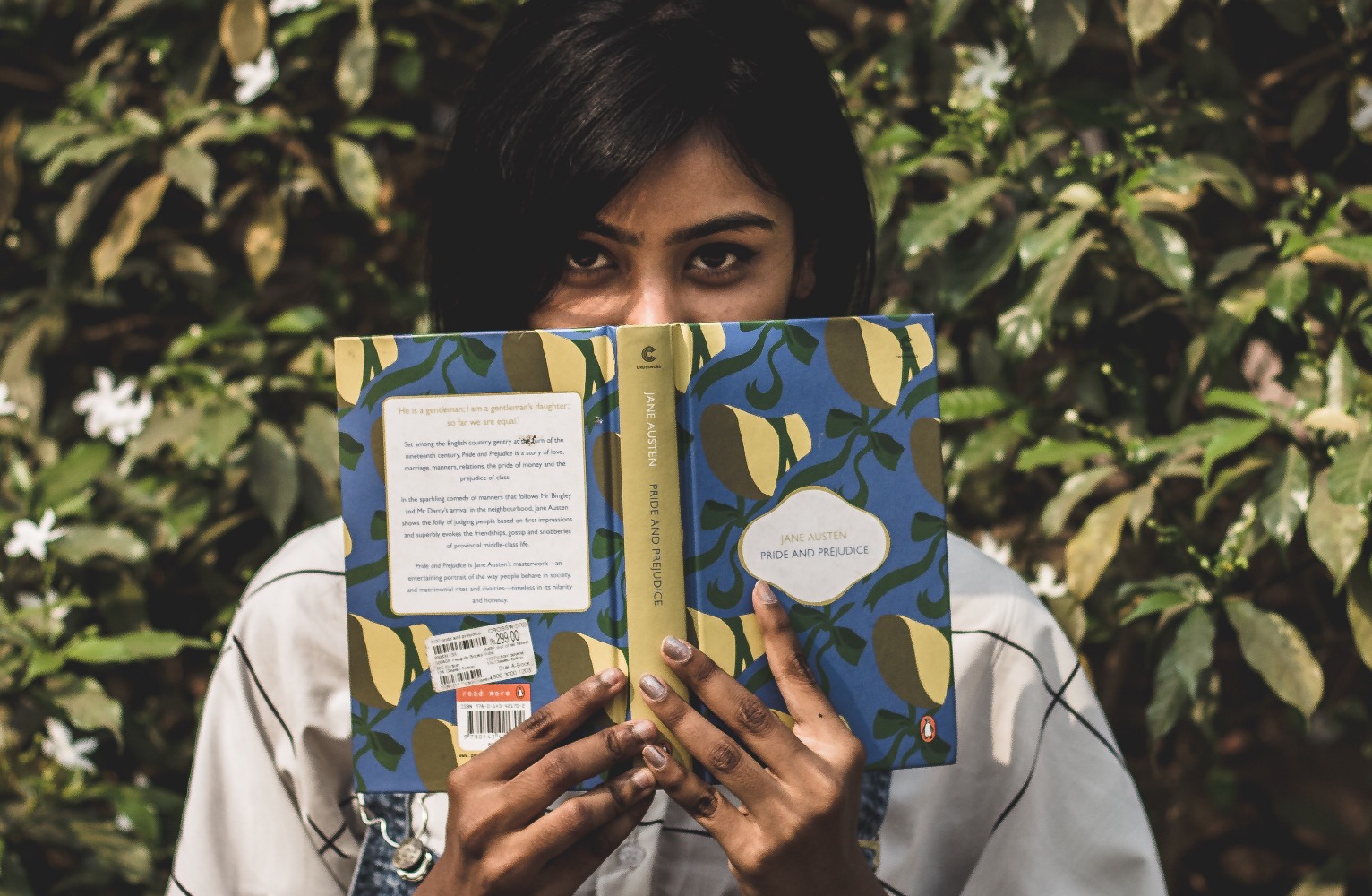All writers and readers have an opinion on literary tropes—which ones they like, dislike, and think are overdone, as well as those that reserve the author (or consumer) a spot in the third circle of hell.
If you’re new to the party, tropes are common literary devices or clichés. They can be phrases, situations, or images, and they’re born from familiar patterns of storytelling that audiences find compelling. For instance, forcing a hero to choose between two different love interests adds a tangible layer of tension.
However, a trope can be executed correctly to the audience’s delight, or incorrectly to the audience’s chagrin. Rather than disregarding these tools altogether, you need to learn how to capitalize on them. One of the best teachers of that art is literary master Jane Austen. Her works contain three romantic tropes that are recognizable yet effective.
Trope #1: The Love Triangle
This is arguably the most overused and hated trope in fiction (I’m looking at you, YA fantasy). Usually the players are one woman and two men, and the need for a decision is delayed as long as possible. The Great Gatsby gives us Daisy, Gatsby, and Tom; The Hunger Games features Katniss, Peeta, and Gale; and of course Twilight showcases Bella, Edward, and Jacob.
The problem with the love triangle is that it’s implausible. While we relish the idea that two impossibly attractive members of the opposite gender would be willing to fight for our affections, the resulting fiasco is unrealistic and unhealthy. If two people catch our attention, we might engage in romantic overtures with them simultaneously. We could call it a “like triangle” or “lust triangle.” But if it’s not exclusive, it’s not true love, as the threesomes Austen wove into her classic novels demonstrate.
In Sense and Sensibility, Marianne Dashwood is admired and pursued by Colonel Brandon and John Willoughby. Yet she accepts Mr. Willoughby’s advances and declines Colonel Brandon’s. Once the colonel becomes aware of her preference, he withdraws. Tension develops as the story reveals Colonel Brandon’s past and character after Marianne has made her choice. Because he’s honorable and deserving, the audience feels empathy for him. Any other course of action on his part would be inappropriate and distinctly selfish. His attraction isn’t the same as love. (Spoiler: Marianne does change her mind and team Brandon gets a happy ending.)
Indecision is fun to write—and if you incorporate a love triangle, your story isn’t doomed. It’s an opportunity to explore true love with your audience. Determine early on whether the romance is motivated by a healthy understanding of love or misconstrued infatuation. Both will have engaging plot developments. Just remember that love acts out of self-sacrifice, whereas lust acts out of self-satisfaction. As your protagonist progresses through the story, let her choose her suitor and don’t drag it out. Instead, create suspense through the consequences. That will make your love triangle unique and establish deeper realism readers will connect with.
Trope #2: Love at First Sight
This second trope riles people up, myself included. The moment the male and female protagonists lay eyes on each other, they fall passionately in love. Drama increases when they must fight to reunite or protect each other from pending danger. Think Romeo and Juliet or most fairy tales.
Undying love is a cathartic emotion we all desire. Who doesn’t want a lifelong, unshakable romance (besides misanthropes)? But the issue with “love” at first sight is that it starts with physical appearance (usually chiseled and ravishing) and never dives much deeper. We’re annoyed because we know that attraction is only a piece of a larger, meaningful puzzle. To fall instantly in love cheapens true romance.
Northanger Abbey, Austen’s parody of a gothic novel, contains her only usage of love at first sight. Gothic novels were melodramatic, scandalous, ridiculous, and all the rage in Austen’s era. Her parody mocks the literary devices of her period, including the fated allure of the hero to the heroine.
Catherine Moreland, an avid reader of gothic novels, spends an exciting winter season in the city of Bath, where she meets Henry Tilney. She’s immediately enchanted with him, favoring his company over every other man’s. As Austen imposes graphic novel traits onto a simple clergyman, she laces Catherine’s assumptions and expectations with humor to show that her imagination is clouding her judgment. She also adds depth to the folly of Catherine’s sentiments by juxtaposing her friend Isabella Thorpe’s interactions with Henry’s older brother, Captain Tilney. Though Isabella is already engaged, she allows her crush on Captain Tilney to destroy her relationship with her fiancé.
Austen uses attraction as a springboard, not a foundation. She illustrates how amorous emotions affect characters and slyly highlights the wisdom and foolishness of their decisions. Catherine eventually realizes her mistakes, which leads her to discover the merits of Henry’s character, and she doesn’t pronounce her true love for him until closer to the end of the novel.
When writing intense physical attraction between your characters, don’t be shy, but don’t forget that appearances are often deceiving. Take advantage of that to generate conflict and surprising plot twists that will set your novel apart.
Trope #3: Handsome Billionaire Falls for the Regular Girl
The staggering amount of material involving rude rich men falling for plain Janes exposes audiences’ weakness for this trope. People reap enormous satisfaction from a regular person challenging the superficial world of the wealthy. Books that follow this trope often cross over into erotica, such as Fifty Shades of Gray and numerous other bestsellers.
The appeal of this trope is the transformation of the beastly man by his love for a “real” woman with a highly developed moral character. But the pitfalls are twofold. First, the trope relies on physical attraction to provoke deep personal change. While sex is a powerful motivator for many people, sustained character growth must be grounded in the spiritual reality of repentance and grace. Second, only one person in the relationship is required to acknowledge their faults. But romantic relationships bring out the worst (and the best) in both partners. Mutual commitment requires both individuals to mature. Austen’s popular novel Pride and Prejudice displays the most famous example of this trope.
The road to happiness for Elizabeth Bennet and Fitzwilliam Darcy is paved with pain. Elizabeth slowly casts a spell over Darcy, who is confident that she can’t refuse to marry a man of his property and position. The resulting mess serves as a mirror to readers, inviting them to identify with Darcy and Elizabeth’s failures. When Darcy undergoes a convincing transformation, Elizabeth recognizes the resentment that fueled her own actions. He changes her as much as she changes him.
The romantic collision of rich and poor builds an arena for characters to battle for love through revelation and change. When physical attraction is at the epicenter, the transformation won’t last, because people’s appearances degrade with time. Transformation that’s inspired by repentance, however, endures. Elizabeth and Darcy are driven to reform, not because they wish to please another person, but because they see their own flaws.
When you write your billionaire bad boy (or girl), remember Austen’s examination of human nature and beware of superficial transformation. A character’s perception of the world is limited by her narrow experience. Ask yourself what the characters’ assumptions are, how they’re wrong, and how they might influence and sharpen each other. You’ll remake a familiar romantic equation into a captivating, thought-provoking story.
The Impact of Finely Crafted Romance
Romance is not a dirty word—it’s foundational to human experience. Part of Austen’s genius was her understanding of human nature. She wrote stories about men and women in the most mundane of circumstances, capturing audiences with humor and honesty. Never pulling punches, she instead wielded romance to communicate deep questions about life to her readers.
You can do the same.
Editor’s Note: This article was originally published on March 30, 2020. Updated February 14, 2022.

Rose Sheffler is a Kentucky native who began her writing career in the seventh grade by hijacking a simple assignment and turning it into an elaborate creative piece. Her teacher reprimanded her for not following the instructions and said, “You should be a writer.” She studied English Literature in college, with a focus on creative writing, and returned to teach seventh grade English at the same private school. Her favorite genres are fantasy, historical fiction, and fairy tales.
This summer she completed a manuscript of new fairy tales and hopes to have them traditionally published. Until then, she homeschools her three kids, feeds her philosopher husband, grades papers, engages daily with her church community, talks to herself, updates her blog, reads too many children’s books, considers the brevity of life in the face of eternity, and takes bookish photographs for Instagram.



















Ahhhhh! Yes. Yes. Yes. Love this, Rose, you did a fantastic job! Jane Austen would be proud. 😉
You could give no kinder commendation than that! Thank you!
Really good post, Rose! While I’m really not a fan of Jane Austen (I loved Northanger Abbey though) this is a great demonstration of how to write a good romance. I’ll definitely be keeping these points in mind 😀
Northanger Abbey is, in my opinion, one of Austen’s funniest books. I’m glad you found something useful here, even if Austen isn’t your favorite. Good luck!
Excellent points. Great article Rose!
Thanks 😉
This is fantastic! I love how Jane Austen manages to write charming and compelling romances that really make you think. A lot of popular YA romance is so cheap and unrealistic next to it, but I have wondered before why the same tropes used in different stories can have such different impacts. Thanks, Rose! 😀
Thanks for reading. Dig deep into Austen and you’ll find so much rich material to imitate. She was a genius when it came to depicting people.
I love Jane Austen so much; my favorite author, actually! My favorites are definitely Emma and Sense and Sensibility. She is actually the only “romance” I will read. I like some romance within other genres, but books in the romance genre, for me, is only acceptable if written by Jane Austen. She has helped shape my standards and what is really important to me in a future husband. I am NOT going to settle for a Mr. Collins or Mr. Elton, thank you very much! 😉
And I’m certainly not going to settle for a Willoughby! *gags*
You are very welcome! I’ve said Jane Austen is the Queen and I stand by that proclamation. 😀
This was a really good article, thanks 🙂
Emma is definitely my favourite xD
I love Emma! So good. Thanks for reading.
*Claps* Wonderful, wonderful:)
*bows* Thank you. It was a blast to write this article.
Annnnd my love of Jane Austen and her works is strengthened all the greater. 😂😍
Excellent! Cheers.
Pride and Prejudice all the way, personally. 😜 I was browsing for articles on writing romance and this one caught my eye (obviously, if Jane Austen is involved 😉). It’s amazing how she did it all, isn’t it?
Thanks for this, Rose! Great stuff.
P.S. Is it just me, or does the girl always choose the wrong dude in love triangles? 😝 Jk, sort of.
Thanks for this article! Austen truly is the queen of Christian romance 😍